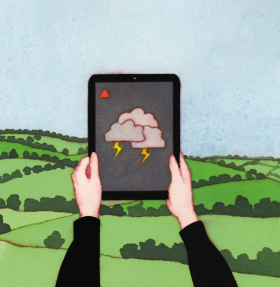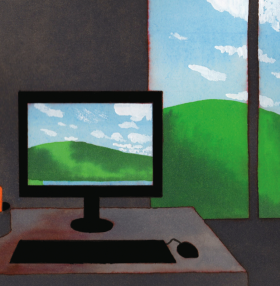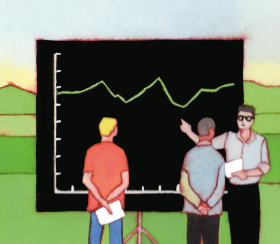Ressources dossier
AgroecologyAccelerating transition, but not at any cost
Published on 07 April 2023
Following the arrival of Fintech, Medtech and Foodtech, Agtech1 has now hit the markets. Attracting a hefty 51.7 billion dollars of global investments in 2021, the digital farming industry has seen the creation of thousands of startups across the world, including some 400 in France. With an eye to its development potential, investors and entrepreneurs have now turned digital agriculture into a priority market. Its development is surging in response to a variety of needs, despite certain constraints imposed by a sometimes poor fit between the practices and knowledge accrued by the tech industry and the workings of agriculture. Véronique Bellon-Maurel describes the work being done: “The development of a form of digital agriculture adapted to agroecology is now underway. A whole catalogue of smart benefits, including new ways to acquire and process data, automated tasks, internet connectivity and on-line exchanges, is providing us with the opportunity to develop a comprehensive set of solutions that can help the transition towards sustainable agriculture and food systems that respect the needs of both humans and animals. We do nevertheless still have to make sure we fully understand the risks, so we don’t end up going down the wrong path.”
1. The use of technology in agriculture, horticulture and pisciculture (software, automation, data analysis) to improve the yields, efficiency and viability of the farming sector.
Accessibility and the co-creation of tools
Information technology enables major gains to be achieved in production quality, environmental co-benefits and reduced costs (fewer fertilisers), with the potential to benefit large numbers of people. But we still have to make sure that the intended beneficiaries, in this case farmers, are in fact able to access and enjoy the promised rewards.
Out in a farmer’s fields, or in the livestock sheds, sensors tend to function individually often without access to mains power. Ingenious solutions can be needed to help them transmit their data. WiFi is out of the equation because it uses too much energy, and the coverage provided by cellphone networks (3G, 4G and 5G) is still incomplete in agricultural areas. Although in France the 3G network has recently been greatly expanded and now provides a service to 95% of farmers, 5% still have no connectivity and often only the farm office can pick up a signal. Last, even when they have coverage, 5% of farmers still have to cope with low speeds. “We need to set up spontaneous networks that can communicate from one sensor to another, or that can sometimes operate as part of hybrid networks, interacting with passing drones or tractors”, says Nathalie Mitton. “The idea is for the system to be sufficiently agile to seize on every possible communication route, even using community radio frequencies.” Establishing full network coverage in rural areas thus still needs to be encouraged.
Digital tools can make a positive contribution to a farm’s viability, but they can only do so if farmers and the agri-food sector are prepared to use them. A DSS, for example, if it offers too many warnings, or is too complicated to use, may well be abandoned. INRAE’s researchers, especially the members of the #DigitAg team, are working to identify the obstacles and drivers associated with take-up, seeking to establish whether the data are relevant and clearly presented, and whether interfaces are ergonomic and easy to use. Other than these technical and practical user-focused issues, there is also an ethical concern over the purposes to which users may put their new-found knowledge. Here, the process of open innovation can help in the search for answers, allowing all stakeholders to be included from the outset.

Florence Amardeilh, co-founder of Elzeard, looks back on the development of her planning software for fruit and vegetable farms: “When I went out to visit farmers, I realised that the fruit and vegetable growers were still working with pencil and paper or using Excel spreadsheets. As I didn’t want to simply impose a tool on them, we started by learning the business and we spent time with them on the ground. It took two years of conversations before we wrote even a single line of code.” Accessibility is, of course, also about costs, or rather about the cost/benefit ratio for professionals who are seasoned borrowers when they are confident that a capital investment will deliver what they need. Margins are all the more critical because a farm’s viability relates to its size. Xavier Reboud recalls the experience of AirInnov, a startup that offered to provide farmers with aerial images of their fields. “It seemed as though the drone would be a real help in improving the processing of in-field data because it allowed better monitoring of the crops, but the company went into liquidation. With an average annual margin of just 70€ per hectare, some of the farmers stopped using the service because it cost too much.”
Good data governance and protection of the data supplier
A single piece of data has no value. Combined with other data, though, it can become extremely useful. Compared with other sectors, the data collected for agricultural purposes often comes from a very wide range of sources. This introduces question marks over quality control and interoperability, both preconditions for any system to work properly.
In its 2019 report, “Cost of not having FAIR research data”, the European Commission reported an annual cost to Europe of 10.2 billion euros from poor data management in research, measured in time spent, cost of storage, licence costs, research retraction, double funding, lack of interdisciplinarity and loss of potential growth. It stressed that, contrary to popular wisdom, open data and its sharing can be beneficial, even to data holders. Indeed, a recent analysis of scientific publications has shown that citation rates are higher for publications with linked data
because of their greater accessibility. The Commission, like the French State, is working to increase open data, speaking out for the principle of FAIR data (Findable, Accessible, Interoperable, Reusable). In July 2021, the French government asked INRAE to set up and manage the Recherche Data Gouv platform. Since July 2022, the platform has offered a multidisciplinary storage facility for all researchers who seek a secure space to upload their data.
Isabelle Piot-Lepetit, has observed and argued for the need for transparent stewardship in the collection of data from individuals: “In a thesis on common goods at #DigitAg, one of our doctoral students attempted to set up an open seed platform for farmers. The farmers refused to cooperate, preferring to stick to closed data systems for clearly defined on-farm purposes with identified returns. To develop open systems and pool information, there has to be trust in the stewardship of the data. Data-management rules, in particular, need to be put in place so that participants don’t feel exploited and retain the sense that they still have agency within the system.”
Issues can also often arise over the particular vocabulary used by those working digital technology. Research teams such as the working group of the AgriSemantic Research Data Alliance (RDA) are seeking to create a “shared language” that would facilitate the exchange and sharing of agricultural data. To achieve their goal, the researchers are studying the different vocabularies in use and the semantic links between them.
Beyond the issues of quality surrounding the collection and storage of data, we need to be able to collate data derived from different sources and of different kinds. For this, shared standards need to be defined. INRAE is a member of the Agro EDI Europe Association2, which works to facilitate the exchange of electronic data between stakeholders in the agricultural world. Although the standards that are already in operation in the supply chain (for invoices, orders, etc.) now ensure the success of 99% of transactions, many other standards still remain to be defined, in particular those that relate to data on the individual parcels of land owned by farmers. “A standard is a bit like the grammatical structure of a sentence. For each purpose, we create a sentence structure, add elements and document the data. For the ’invoices’ standard, for example, we start with international norms and we then add in the details that are needed for the agricultural sector. At the same time, we also create reference systems that assign the same binary code to each word in our sentence. You could say that we are the editors of a common dictionary for the sector”, explains Marie Buerret, head of the projects and communication section at Agro EDI Europe.
2. The Agro EDI Europe Association (EDI = Electronic Data Interchange) was formed in 1992 by La Coopération Agricole, l’Union InVivo and the Association Nationale de Révision. The work of this cross-sector group is directed towards the creation of norms and standardisation for messages and exchanges to ensure that systems in the agricultural and food sectors are interoperable.
The need for digital to support individualised and human forms of management

“We wanted to find out how the next generation viewed digital technology in farming”, Xavier Reboud tells us. “So the Relance Agronomique GIS (scientific interest group on agronomic revival) launched a bande dessinée competition in engineering schools and agricultural colleges which they called ’Tomorrow’s @griculture’. The 57 entries it generated in 2018 expressed, among other things, the worry that excessive use of digital tools would interfere with the relationships established by humans, not just with animals but with the soil itself. Concerns were expressed that digital systems could lead to excessive standardisation, or even some sort of alienation, that would be detrimental to individualised and human forms of management.”
The sort of scenario they envisage might go as follows, taking the example of a pig farm. Because it is hard to tell just by looking at an animal whether it has a fever, a pig farmer might install infrared sensors to monitor the animals, making it possible to check a pig’s temperature in real time, and even to receive an alert when it gets too high. In this instance, digital technology is clearly providing a useful service. But the system can also offer a further service, automatically releasing a dose of medication into the animal’s feeding trough, having identified the animal by its number. Rather than alerting the farmer, who would then look for the cause of the fever and treat the animal, the system automatically takes over the treatment of the individual animal. This replacement of farmers by machines can be perceived as being a retrograde step – by delegating their expertise to machines, farmers are downgraded to the status of mere technicians who work under the direction of the machines to achieve the smooth functioning of the wider system. Rather than being “empowered” because they have been provided with information that was initially hard to access, farmers find that their expertise has instead been diminished by technology. Sociologists call this de-skilling.
A form of digital in agriculture that is familiar to many is the use of precision farming apps. These allow users to follow decision-making pathways that have been developed using modelled data. The user’s actions are mostly directed towards specific locations or individuals that “require treatment” according to a simple economic rationale. Véronique Bellon-Maurel believes that we need to move on from this paradigm, as she explains: “We shouldn’t just use these technologies to control non-conformities within the system that are defined by their impact on economic performance. Modern digital products are quite different from the older precision-farming devices; they are both easier to use and they look beyond the limits of the field. Our goal is to build a form of IT that will support the wider processes of agroecology and can accommodate the diversity and independence of farmers.”
Counting the costs to the environment
Information technology is estimated to have consumed around 12% of France’s total electricity output in 2019 according to the country’s General Council for the Economy, Industry, Energy and Technologies. The question of environmental impact is as important for digital agriculture as it is elsewhere and must be addressed. The white paper Agriculture and Digital Technology, co-authored by Inria and INRAE, accordingly emphasises the need to “reduce energy expenditure, the consumption of other resources (whether they are renewable or not) and the pollution caused by the use of these technologies.” It goes on to explain: “The development of digital solutions must thus be considered in terms of costs: equipment (e.g., parts used, size, number, particularly for sensors and robots); data produced (e.g., nature, number, storage); the power needed to run the software. So that the goal is always to save natural resources (e.g. water, minerals) and energy.”
According to Nathalie Mitton, “We are currently not in a position to evaluate these consolidated overall costs in terms of energy, materials and pollution. For example, the in-field telemetry systems that measure the moisture content of the soil and target parcels for irrigation achieve considerable water savings. But how much water is needed to extract the precious metals and rare earth elements required to produce these systems? And the recycling of the sensors also uses water and electricity. In the end, you have to wonder whether we have truly achieved environmental net gain when you look at the whole supply chain.”
The development of digital solutions must thus be considered in terms of costs: equipment, data produced and the power needed to run the software.
The use of digital tools in agriculture calls for sobriety. Life Cycle Analysis (LCA) methods developed by INRAE’s ELSA hub in Montpellier, combined with data from the MEANS platform, make it possible to establish the “whole life” environmental costs of manufacturing a product (from the materials used to the energy that is consumed for supply-chain logistics, through to its ultimate destruction/recycling). INRAE and #DigitAg are jointly studying the environmental costs of the use of digital technology in the agrifood sector from a sociological and economic perspective. The project’s principal lines of investigation include the effects of restricting sensor numbers, the choice of systems that use the least energy, the use of manufacturing equipment with long lifespans, and support for High-Low Tech. MIT’s High-Low Tech principle offers solutions that integrate high tech elements (electronic modules, computation) with low tech structures. It uses simple, undemanding technologies that are freely accessible and easy to repair, drawing on common methods that are locally available, and it incorporates recycling. The development of High-Low Tech often takes place collectively by end-users in FabLabs.
Cooperatives and Chambers of Agriculture also have a contribution to make, especially through the work they do to ensure that the innovations offered by information technology companies meet the specified needs of their members. They are prepared to suggest different directions for development to AgTech businesses. With an eye to their own bottom lines, they might be tempted to propose options that are certainly attractive, but are expensive, of little utility, and harmful to the environment. The need for such interventions is all the greater because, as we know from the doctoral work of Éléonore Schnebelin3, while it is indeed true that some AgriTech professionals strive to take the environmental impacts of developing and using their digital solutions into account, others pay them little heed.
As mindsets turn towards sobriety, blockchain is having to reconsider its energy costs, which are all the greater because the network is open to the public. Studies reported on EcoInfo, a CNRS site, estimate that the global electrical consumption of blockchain in 2019 was comparable to that of countries such as Austria, Belgium or Denmark. Work to reduce consumption levels is currently underway, as is flagged by the announcement in September 2022 by the Enthereum project (which brings together both providers and users of bitcoin) of its intention to produce a far more frugal blockchain.
3. INRAE thesis (defended July 2022), which set out to “show how digitalisation interacts with the French system of innovation in agriculture, including its paradigms and the ecologising trajectories of agriculture”.
Conclusion
In recognition of these major concerns and to enable information technology to offer positive benefits for agroecology, a set of four principles has been established by the teams at Inria and INRAE to guide their research and development of the relevant technologies and practices. These are: the inclusion of stakeholders at all stages of the innovation process; the anticipation of risks; responsiveness to external changes; and self-reflection by companies on their actions. These principles allow benefits and practical applications to be maximised, while controlling the risks inherent to any innovation. What steps, then, are research and innovation communities in France taking to apply them in their work?
A travelling apps laboratory

The French Agro Institute has created a travelling laboratory on wheels, co-funded by the AgroTIC Chair and Occitanum.
The mission of this AgroTIC Mobilab is to raise awareness among farmers of ways to apply technology in agriculture. Simon Moinard, who runs the mobile lab, tells us more: “We go out to visit farmers and let them see the range of different sensors for themselves, we explain how they work and what their limitations are. Often, they realise that they have not been using them properly and that, as a result, returns have been poor. These discussions serve a dual purpose: we come away with information on the needs and practices of the farmers so we can develop new sensors that are more relevant, and they become more proficient in their use of the new technologies. They can then enter into a more constructive dialogue with service providers. Although some of them may find digital a daunting prospect at first, they quickly realise that, ultimately, it is quite simple and can enable them to protect their harvests and improve their environmental footprint.”
-
Aliette Maillard
(Send email)
Author / Translated by Teresa Bridgeman
-
Sophie Nicaud
Author
-
Philippe Fontaine
Author
-
Nicole Ladet
Author
